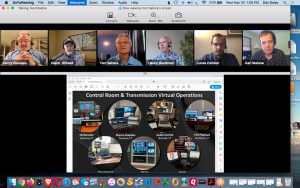DTV Audio Group Webinar Examines Evolving At-Home Workflows
The pandemic has taken REMI-style production to actual homes
Story Highlights
The DTV Audio Group has been holding a series of Zoom-based webinars focused on best practices for broadcast-audio professionals working from home during the pandemic. On May 20, “At Home, At Home? — Expanding Virtualized Audio Production” brought together A1s, audio supervisors, and manufacturers to look at workflows that are evolving as audio mixers and talent work remotely from their own homes instead of in studios and mobile production units.
The webinar’s title is a play on how the increasingly popular operational model in which broadcasters keep most technical assets in the plant — or “at-home”— and deploy a compact array of field assets has been compounded by those workers’ having to work from their own homes during the COVID-19 crisis. The discussion centered on currently deployed communications and monitoring solutions for remote personnel and explored the next steps required to fully virtualize audio operations for “at home, at home” production.
The panel, introduced by DTV Audio Group Executive Director Roger Charlesworth and led by veteran media technologist and advisor Tom Sahara, featured Henry Goodman, product development director, Calrec Audio; Karl Malone, director, sound design, NBC Sports and Olympics; Henry Rousseau, associate director, remote production operations, ESPN; Glenn Stilwell, senior audio engineering and operations manager, PAC-12; Lucas Zwicker, technical product manager, audio production, LAWO AG.
One point raised early in the discussion was that the U.S. has a more difficult logistics challenge than many other countries by virtue of its size. “It’s easier in the UK because they can drive to [many] venues,” said Malone. Several solutions were suggested for putting commentator talent closer to the games they call, including tielines, Haivision’s low-latency codec, and LiveView’s cloud-based Platform-as-a-Service (PaaS) solution.
There were discussions around how best to deliver games without an audience in the stands. Although the consensus has been to avoid sweetening the audio with artificial crowd sounds, it was noted that, for recently restarted Bundesliga soccer league games in Germany on Sky Sports, a DJ played a MIDI keyboard to create sound effects to punctuate key moments in a game. The Haivision and Calrec Assist have been deployed to control the Calrec RP1 and other remotely located production cores, notably for recently restarted NASCAR races on television. The Bundesliga shows are also using Lawo’s Kick, an automated ball-tracking application that opens specific microphones around a soccer pitch as the ball comes close to them.
It was acknowledged that what’s taking place now as a result of the COVID-19 situation is a logical extension of the at-home/REMI workflow that has been increasingly implemented during the past several years. The main difference is that the model now includes announce talent working from their respective homes, as well as a greater and growing reliance on cloud-based systems — such as vMix live-streaming production software and Teredici remote-control software — and connectivity.
Concerns were voiced about latency in this kind of configuration, although it wasn’t deemed a major problem. It was also noted that different users are configuring their remote networks differently: some A1s in the field are using virtual mixers that connect to conventional consoles at the plant; others are placing complete consoles in their own homes.
Although many of the technologies enabling remote operation of audio systems have been in the market for several years, what is remarkable is the degree to which they are now being used and how quickly that has come about.
“The technology to [operate a control surface] over distances from [the console’s] core over IP is already there,” noted Goodman. “[However], we haven’t played with it as much as we have just in the last few weeks.”
Two considerations in doing complex mixes remotely from engineers’ and talents’ homes were that plant-based systems need to be able to easily and reliably interface with the much wider variety of platforms that these workers use at home, such as digital audio workstations and audio mixers, and the availability and reliability of the internet connections in those homes.
“[Poor] connectivity in the field is what plagues us,” said Rousseau, noting the use of Unity intercom systems to connect upwards of 300 people working remotely on a single real-time project. In some cases, it was necessary to send technicians to talent’s homes to adjust or upgrade their internet systems; when connectivity was especially poor, they may have had to rely on a mobile phone as the source of internet connectivity. Also discussed was the need for announce talent in various locations to be able to cover another location if connectivity was lost.
The dispersion of so many workers to so many locations underscored another challenge: equipment-rental vendors’ stretched inventories. Yet another challenge was the difficulty some workers had in finding sufficiently noise-free areas of their homes to work from. These considerations were novel and formed what one participant noted were many new potential points of failure.
“We’re putting so much new equipment in people’s house,” he said, “you have to hope no one trips on a wire [during a broadcast].”
On the other hand, this dispersal of workers on sports shows helps enforce social distancing, particularly compared with the tight quarters of remote-production vans. Furthermore, the nearly total ending of travel to event locations also supports keeping COVID-19 at bay, as well as contributing to the cost savings that are the goal of the at-home model.
The idea of having audio mixers work from a single location for all shows was discussed, with one participant noting that about half the shows he works now use that model. Looking forward, the current situation may result in a completely different way of assigning A1s to shows, based on their location at the time of the game or match.
It’s clear that many of the methodologies used in live sports broadcasts will be radically changed in the future, even beyond the at-home workflows that have already been implemented in search of cost-cutting.

